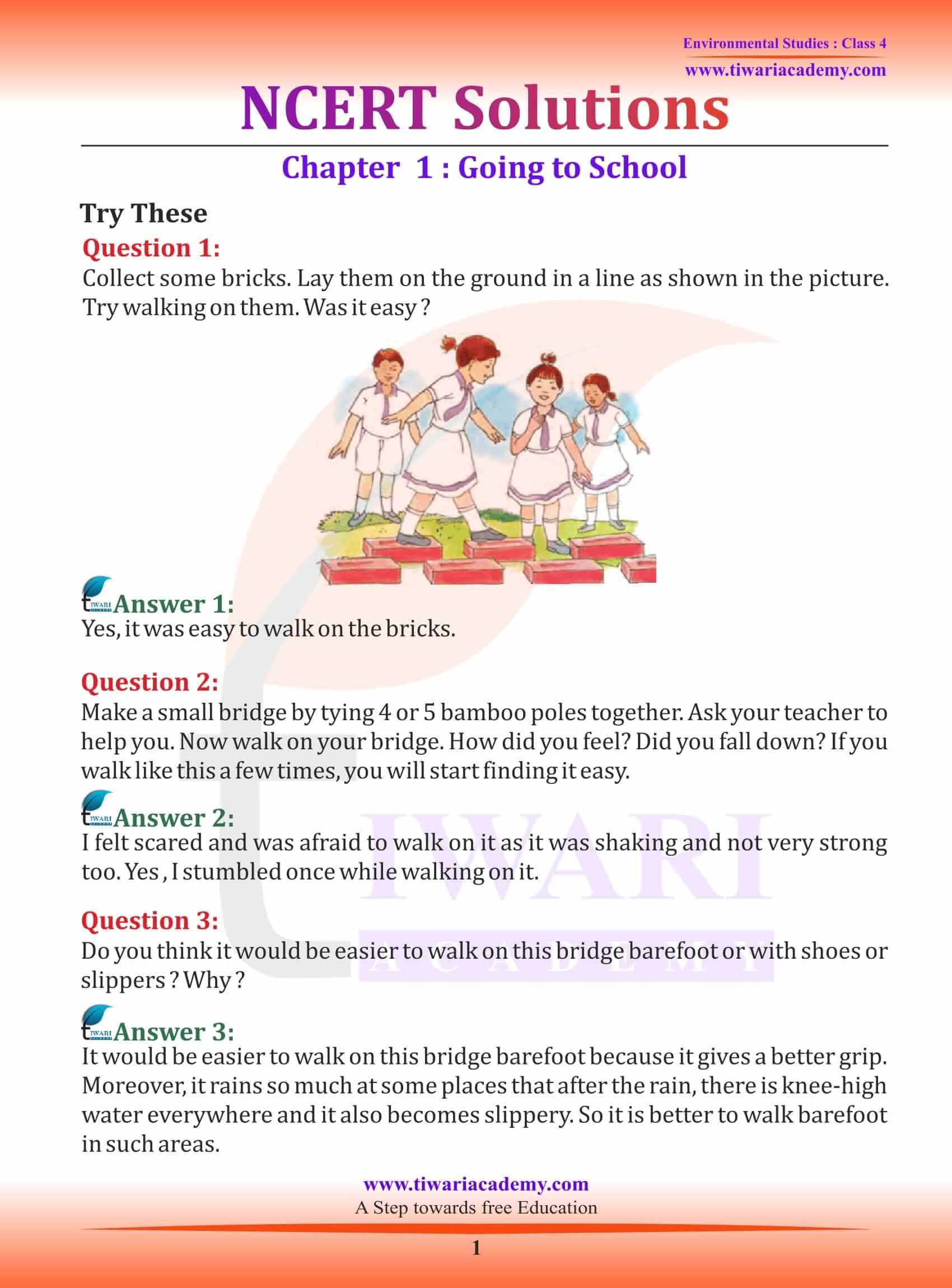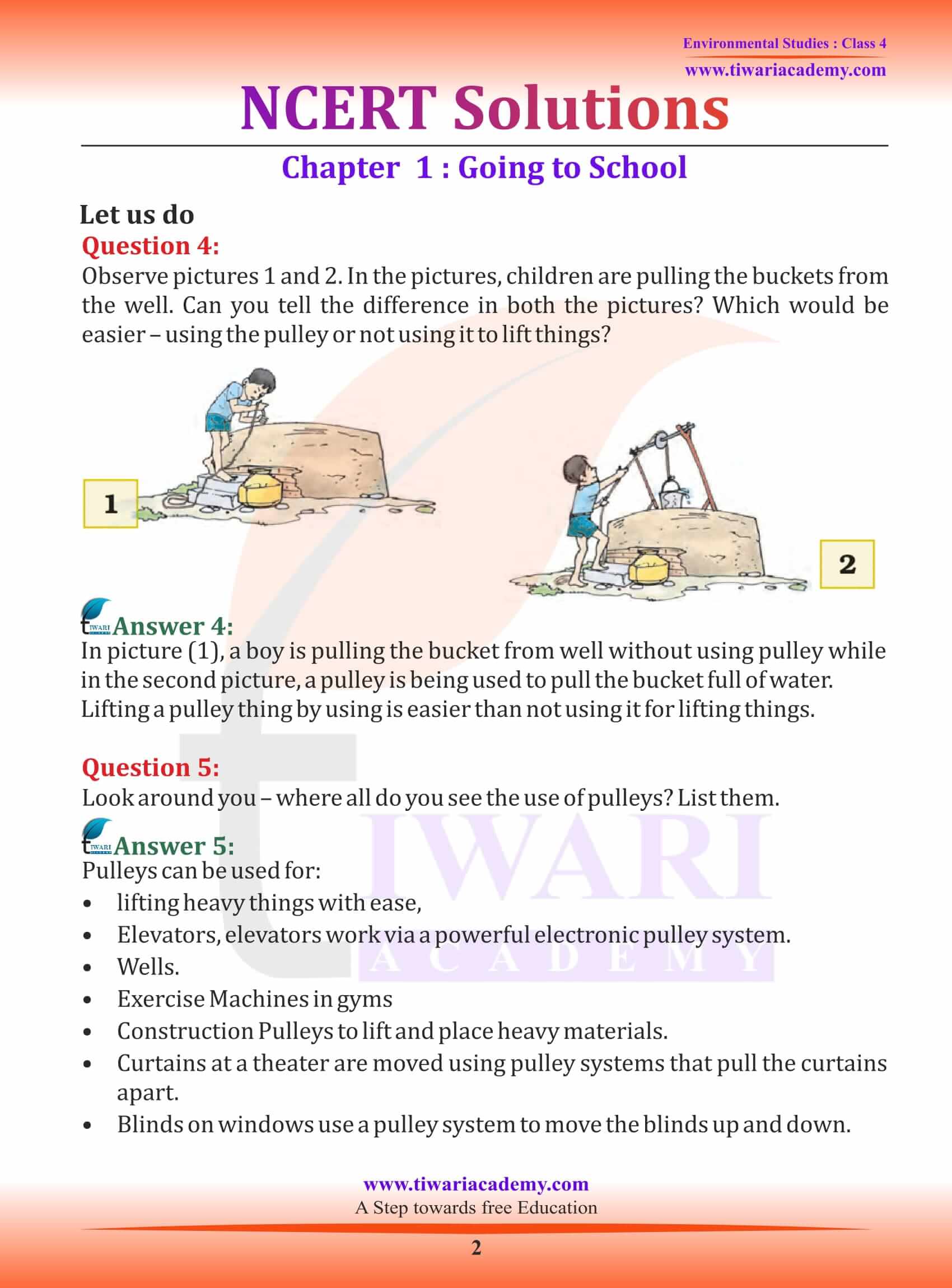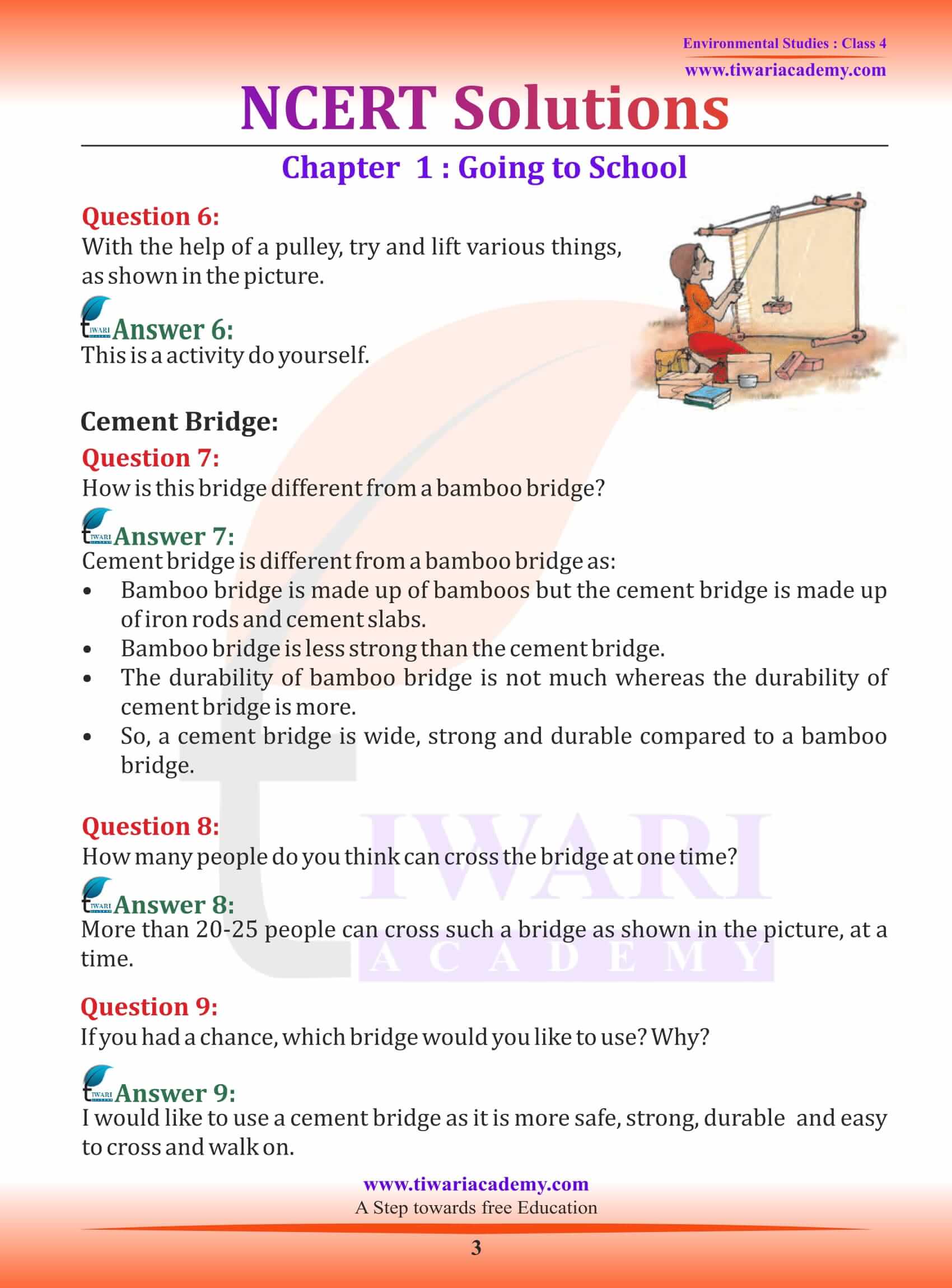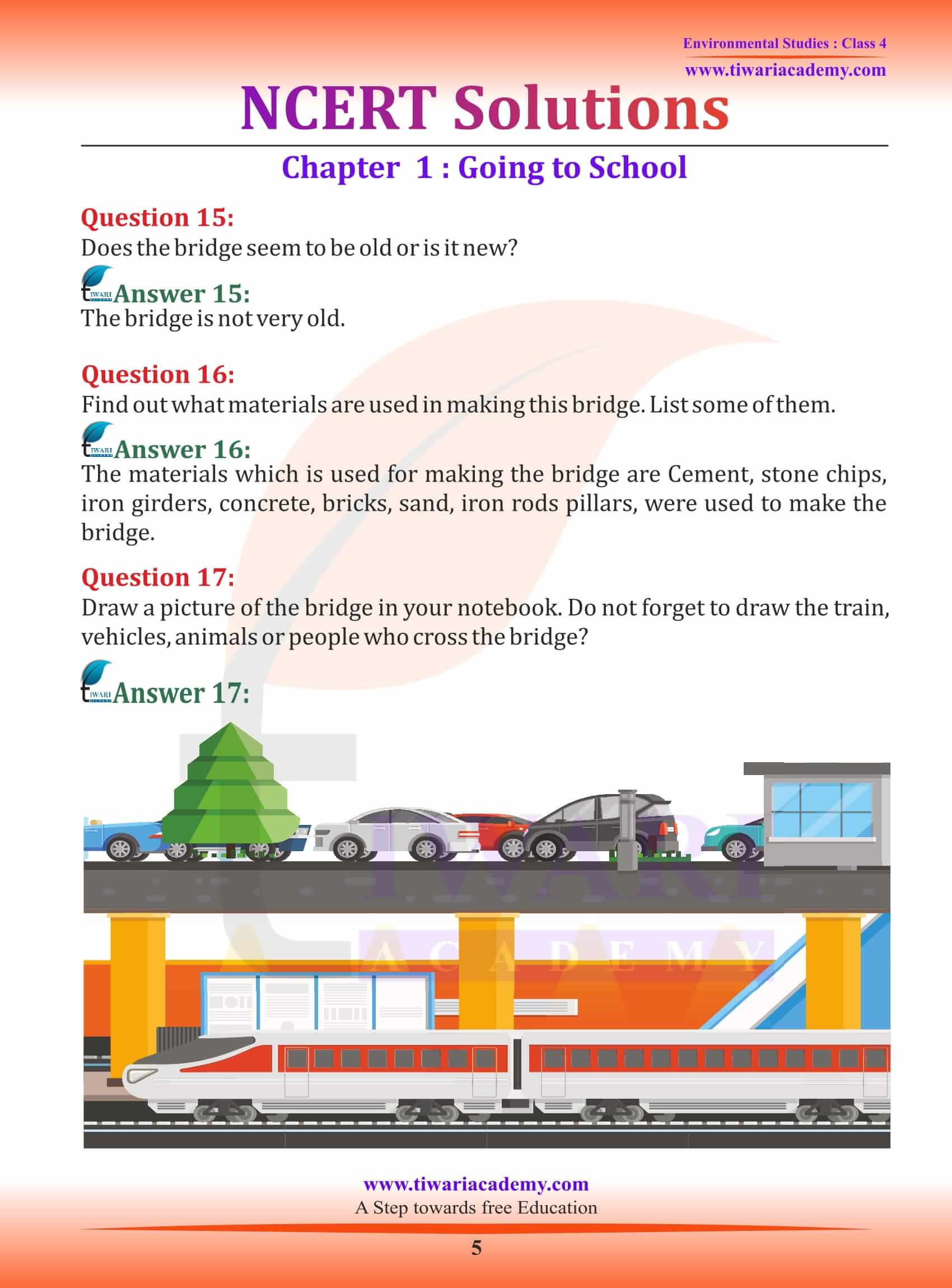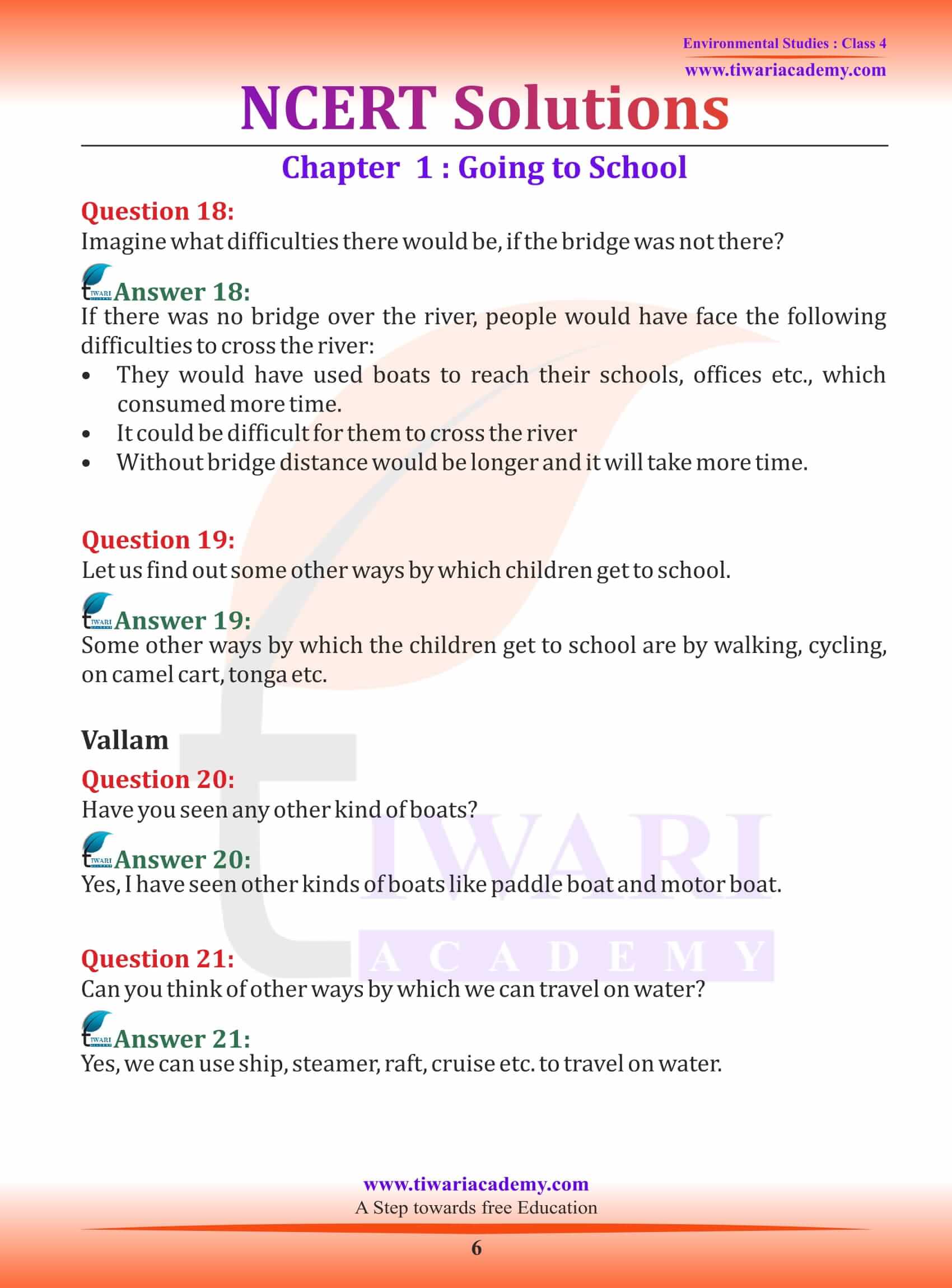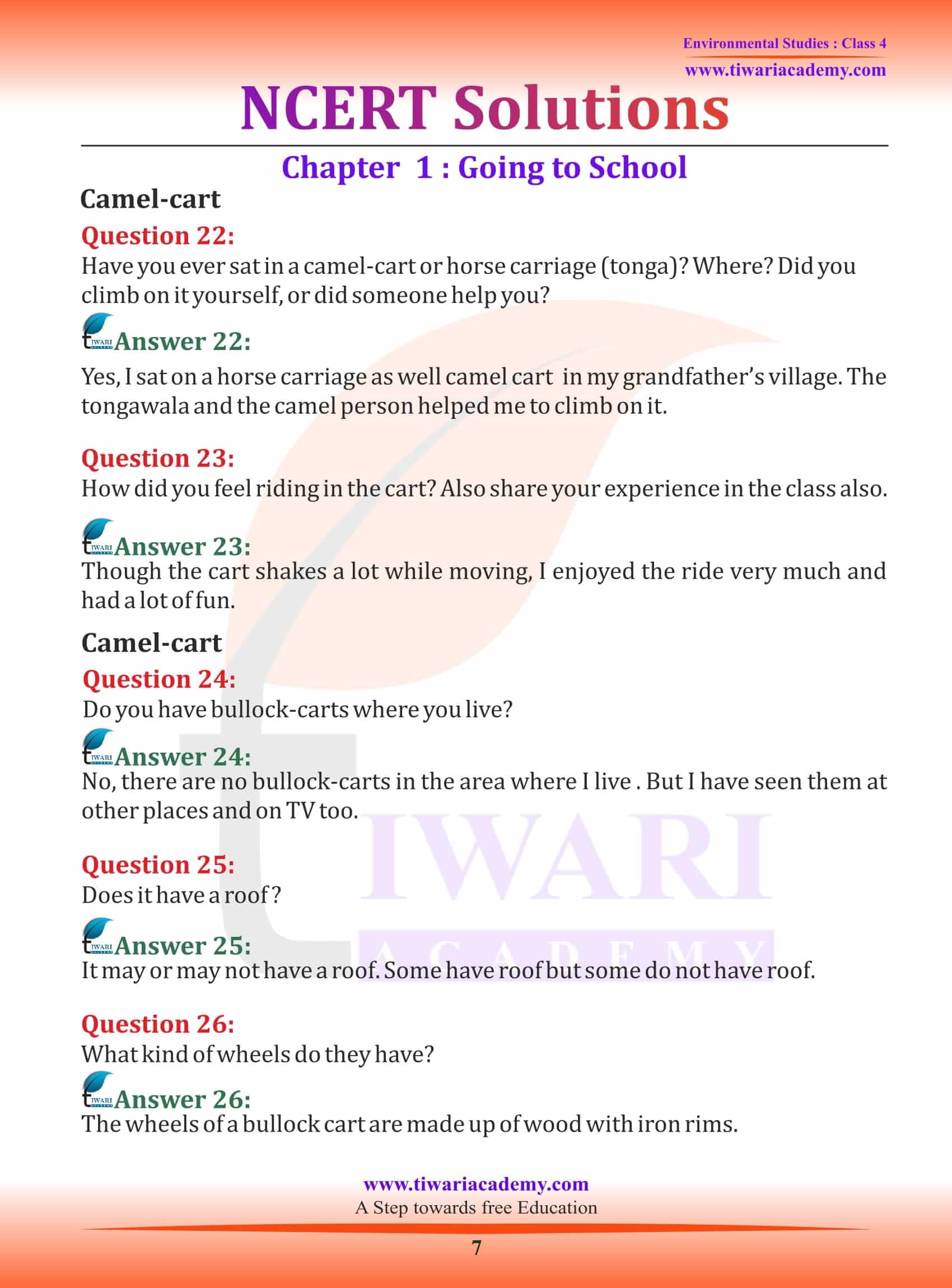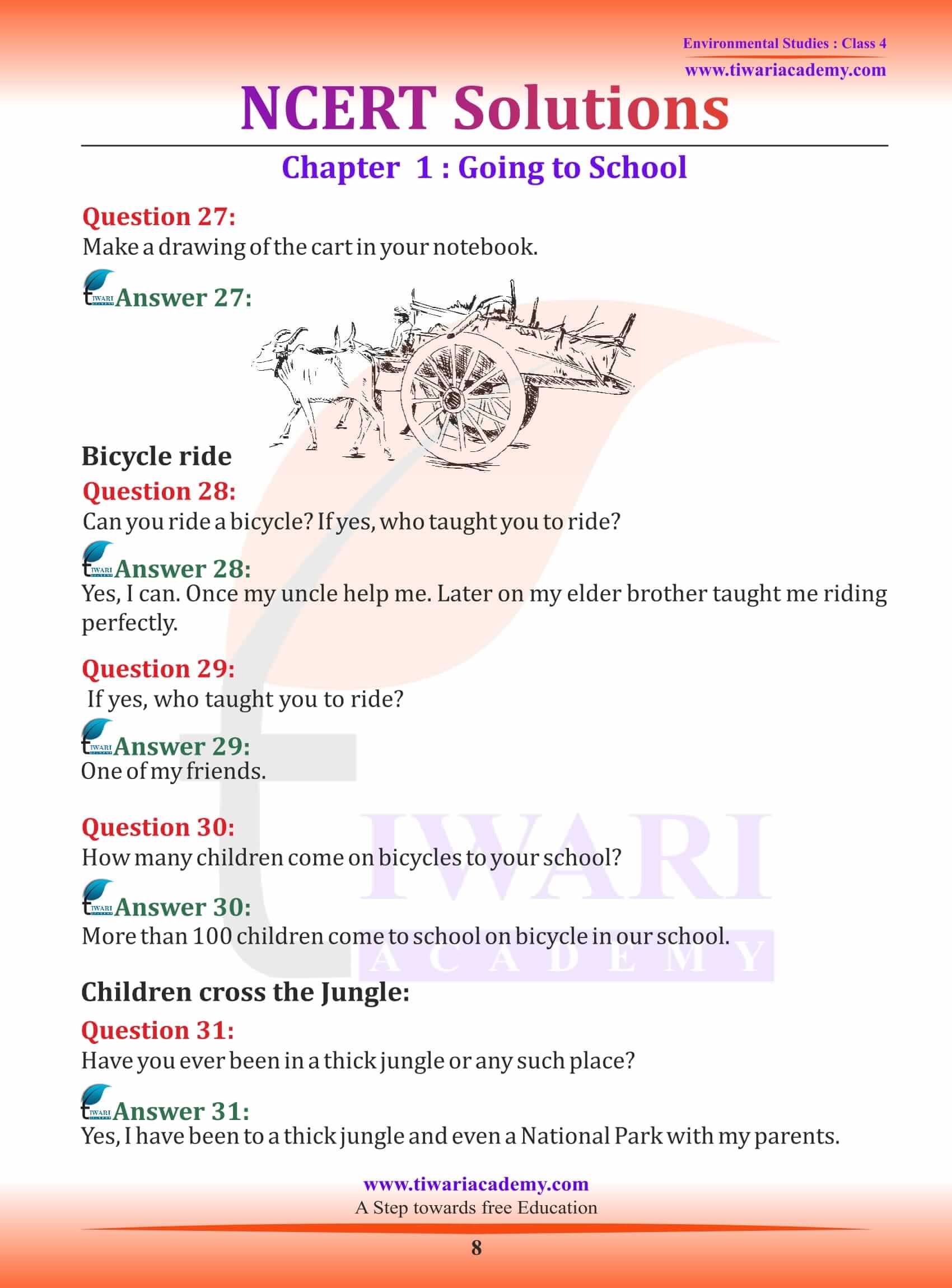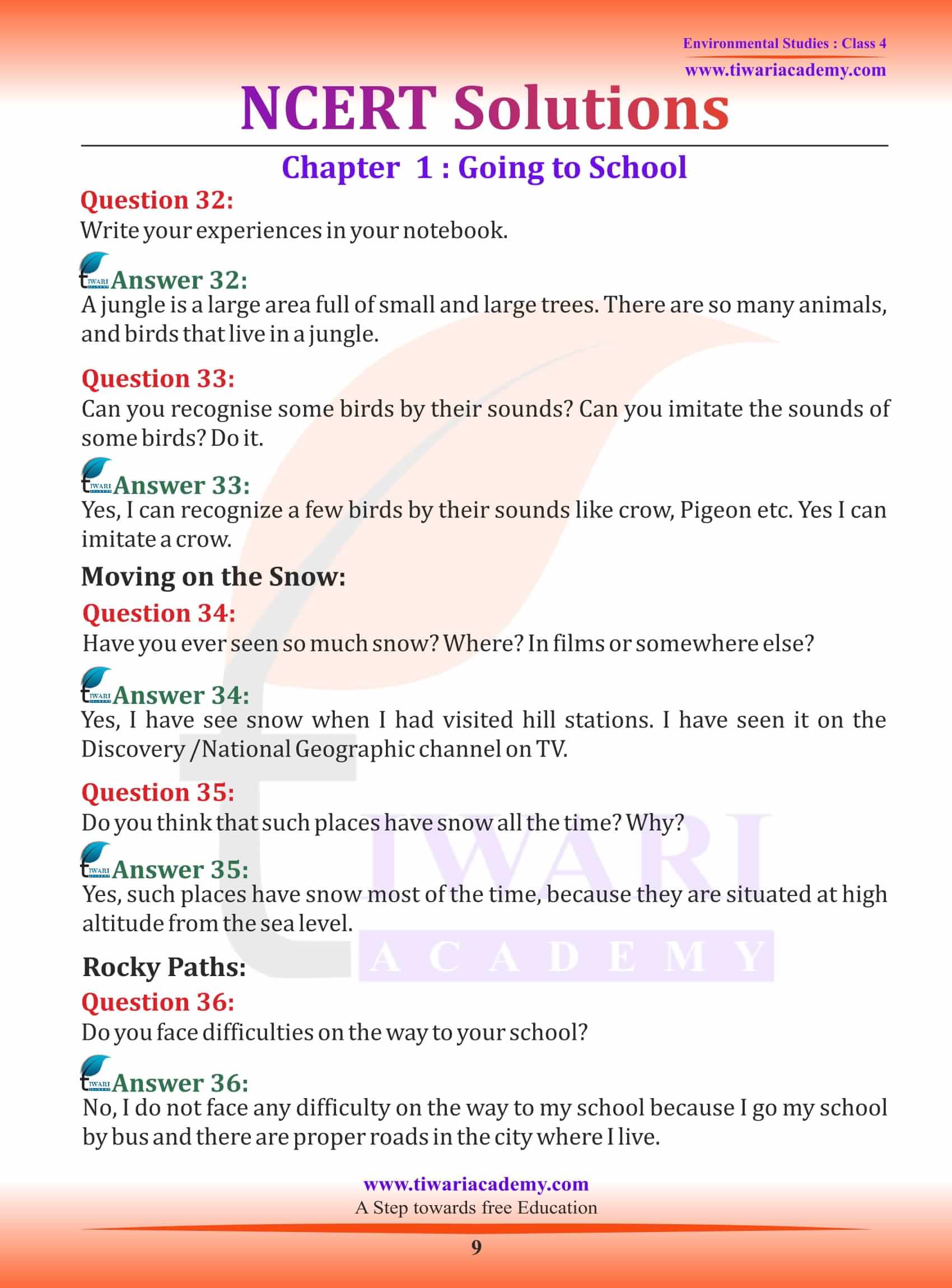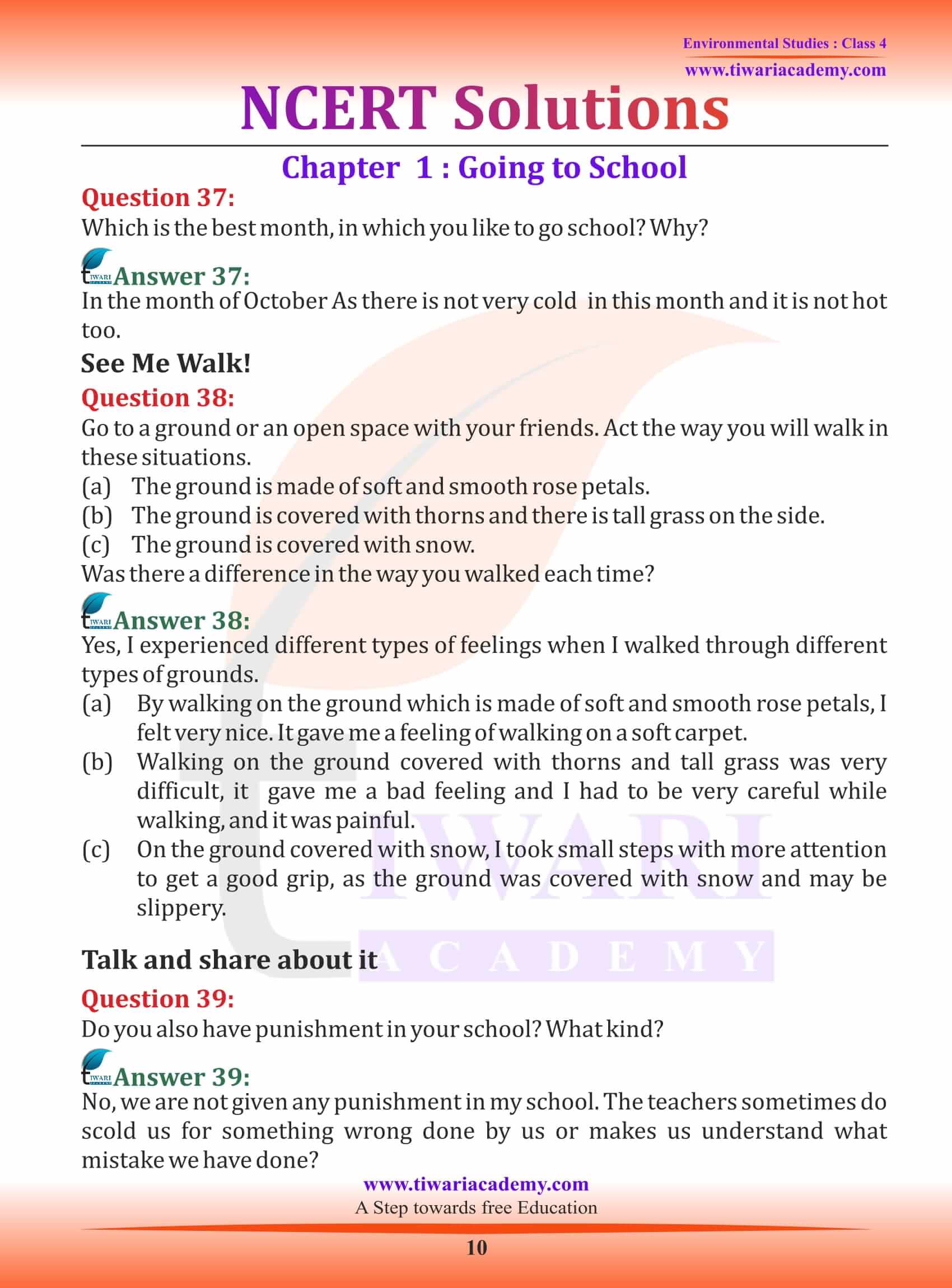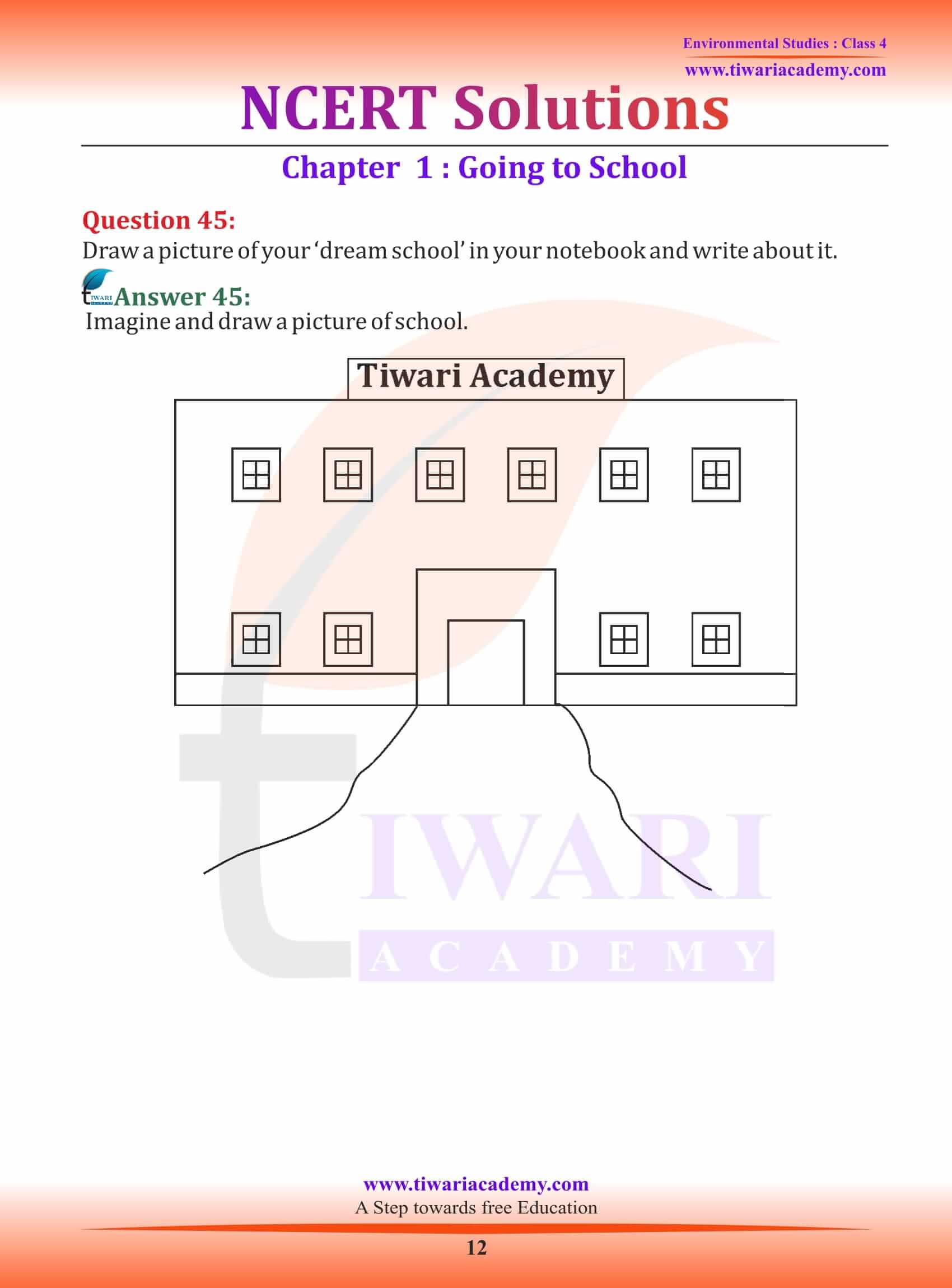NCERT Solutions for Class 4 EVS Chapter 1 Living Together of Unit 1 Our Community updated for New Session 2025-26 in Hindi and English Medium. Class 4 Our Wondrous World Textbook The World Around Us in Chapter Question Answers and the questions given at the end of chapter.
Class 4 EVS Looking Around Chapter 1 Going to School
NCERT Class 4 EVS Chapter 1 Living Together Solutions
Class 4 EVS Chapter 1 Questions at Page 4

Write
Look at the picture of Chandan’s village.
What do you see in the picture? Describe below.
………………………………………….
………………………………………….
See AnswerPeople and Activities:
1. Chandan and his friends are playing football under a big banyan tree.
2. Some elders are sitting and chatting under the same tree.
3. A man is seen cycling on a village path, carrying something on the back of his bicycle.
4. A man wearing a red turban is walking and talking on a phone.
5. A woman is carrying a pot, likely for collecting water from the well.
6. Another woman is walking with a child.
Nature and Animals:
1. There are green trees all around adding to the beauty of the village.
2. A cow is grazing near a pond and there’s a bird sitting on its back.
3. A monkey is sitting on a tree.
Buildings and Infrastructure:
1. There are houses, one of which is painted purple.
2. A post office is visible in the background.
3. A water tank stands tall near the buildings.
4. A well is present in the foreground, with a bucket tied to a rope for drawing water.
5. There’s a red car parked near the post office.
Other Elements:
1. A pond is seen on the left side with a buffalo and cow nearby.
2. Birds are flying in the sky, and the sun is shining, suggesting a nice, bright day.
Activity 1
Explore your locality; observe the people and places around you. Write your observations about how the people and places you see are connected to each other in the table given below.

See Answer
Shopkeeper
• Sells goods like food items, clothes and products for daily needs.
• Sells local products.
• Provides employment to local people.
Road
• Connects people living in different areas.
• Allows easy movement of goods and services.
• Helps emergency vehicles reach people in need.
Health Centre
• Provides treatment for illness.
• Offers preventive healthcare and vaccinations.
• Educates community about health issues.
Police
• Provides safety.
• Helps resolve conflicts in the community.
• Enforces laws and maintains order.
School
• Educates children in the community.
• Creates meeting place for families.
• Hosts community events and celebrations.

Class 4 EVS Chapter 1 Questions at Page 5
Discuss
1: Why do you think it is important to have places like parks, schools, hospitals and bus stops in your locality?
See AnswerThese places are important because they provide essential services and improve our quality of life. Schools educate children, hospitals provide healthcare, parks offer recreation and green spaces for everyone to enjoy and bus stops ensure transportation access. These places create shared spaces where community members can interact, learn, receive care and travel easily.
2: How would life be different if one or more of these places in your locality did not exist?
See AnswerLife would be more difficult and less convenient. Without schools, children would have to travel far for education. Without hospitals, people would struggle to get medical care during emergencies. Without parks, people would have fewer places for recreation and relaxation. Without bus stops, transportation would be limited, making it hard for people to commute to work or school. The community would be less connected and face more challenges in daily life.
3: What can you do to keep these places clean and safe?
See AnswerI can help keep these places clean and safe by:
1. Not littering and using trash bins properly.
2. Participating in community clean-up drives.
3. Following safety rules in public places.
4. Reporting broken facilities to authorities.
5. Taking care of plants and trees in parks.
6. Being respectful to public property and not damaging it.
7. Encouraging others to maintain cleanliness and safety.
Class 4 EVS Chapter 1 Questions at Page 6
Activity 2
Let us create a colourful poster to help Chandan and his friends invite people from their neighbourhood to participate in the Van Mahotsav.

Class 4 EVS Chapter 1 Questions at Page 7
Activity 3
1: Identify the people who help in maintaining your locality. What are their occupations?
…………………………………….
…………………………………….
…………………………………….
See AnswerThe people who help maintain our locality include:
1. Sanitation workers who collect garbage and clean streets.
2. Gardeners who maintain parks and public gardens.
3. Electricians who repair street lights and electrical systems.
4. Plumbers who maintain water supply systems.
5. Security guards who keep public places safe.
6. Municipal workers who repair roads and public facilities.
7. Police officers who maintain law and order.
Class 4 EVS Chapter 1 Questions at Page 8
2. Look at the table below. List different kinds of work required for developing and maintaining the park. Also, mention the material, tools and skills required. An example is given here.

Answer of Above Question

3. Find out from your family members or neighbours about their work. What questions would you ask them? Here are some examples:
(a) What do you like most about your work?
(b) What types of tools or things do you use?
(c) What challenges do you face?
See Answer1. How did you learn the skills needed for your work?
2. How does your work help the community?
3. Have you seen changes in how your work is done over the years?
4. What part of your job makes you feel proud?
5. Do you work with other people or mostly alone?
Class 4 EVS Chapter 1 Questions at Page 10
Discuss
1: It is important for communities to come together in times of need. What do you think about this statement?
See AnswerI think this statement is very true. When communities come together during challenging times, they can solve problems faster and more effectively than individuals working alone. The example of the villagers in Kanker building a bridge in just two days shows how cooperation can achieve remarkable results. Communities that support each other create stronger bonds, share resources efficiently and develop resilience to face future challenges. Working together allows people to combine their different skills and strengths.
2: Do people in your locality come together and support each other? Can you remember one such occasion?
See AnswerYes, people in my locality do come together to support each other. One memorable occasion was during last year’s heavy monsoon when several houses were affected by flooding. Community members organized temporary shelters in the school, collected food and clothing donations and formed teams to help clean up after the water receded. Everyone contributed what they could—some cooked meals, others provided transportation, and many helped with repairs. This collective effort helped affected families recover much faster than they could have on their own.
Class 4 EVS Chapter 1 Questions at Page 11
Write
Think about your family or community. How do you work together to help each other while preparing for a festival or any other occasion?
…………………………………….
…………………………………….
…………………………………….
See AnswerIn my family and community, we work together during festivals by dividing responsibilities. For Diwali celebrations, some family members clean and decorate the house, while others prepare special foods and sweets. Older members often teach younger ones traditional practices and stories behind the festival. Neighbors exchange homemade sweets and visit each other’s homes. For community celebrations, people contribute according to their skills—some organize cultural programs, others handle decorations, and some manage food distribution. Everyone participates in the cleanup afterward. This cooperation makes the festivals more enjoyable while strengthening our bonds.
Class 4 EVS Chapter 1 Questions at Page 13
Discuss
1: What are some of the ways by which we can take care of nature and our neighbourhood? List a few.
See Answer1. Plant and maintain trees and plants in public spaces.
2. Organize regular community cleanup drives.
3. Reduce, reuse and recycle waste properly.
4. Conserve water and electricity in homes and public places.
5. Create and maintain compost pits for organic waste.
6. Avoid using plastic bags and single-use items.
7. Report and fix leaking taps and broken facilities.
8. Create awareness about environmental protection.
9. Use eco-friendly transportation like bicycles or walking for short distances.
10. Protect local wildlife and their habitats.
2: How does helping others and working together make our community better?
See AnswerHelping others and working together makes our community better by creating stronger social bonds and trust among community members. It leads to efficient use of resources and skills as people share what they have and know. Working together solves problems faster and more effectively than individual efforts. It creates a sense of belonging and pride in the community, reducing feelings of isolation. Cooperation also teaches important values to younger generations. When everyone contributes, the community becomes more resilient to challenges and creates a supportive environment where everyone can thrive.
Class 4 EVS Chapter 1 Questions at Page 13
Let us reflect
Our School, Our Team
1: Write the different role people play in your school — teachers, students, caretakers, bus drivers, etc.

See AnswerTeacher: A teacher helps students learn new things.
School bus driver: Safely transports students to and from school.
Principal: Manages the school and makes important decisions.
Librarian: Takes care of books and helps students find information.
Caretaker/Janitor: Keeps the school clean and maintains facilities.
Office staff: Handles paperwork, attendance, and communications.
Security guard: Ensures safety of students and school property.
Canteen staff: Prepares and serves nutritious food to students.
(a) Why is it important for everyone to work as a team in a school?
See AnswerIt’s important for everyone to work as a team in a school because each person plays a vital role in creating a safe, effective learning environment. When all staff members coordinate their efforts, students receive better education and care. Teamwork ensures that all aspects of school life—from teaching to maintenance to administration—function smoothly. It also sets a positive example for students about cooperation and respect for different roles in society.
(b) What is your role as a member of your school community?
See AnswerAs a student in the school community, my role includes:
1. Attending classes regularly and completing assignments.
2. Following school rules and respecting school property.
3. Being kind and helpful to classmates and teachers.
4. Participating actively in class discussions and activities.
5. Contributing to school events and programs.
6. Reporting problems or unsafe conditions to teachers.
7. Keeping the school environment clean and organized.
8. Representing my school positively in the community.
2. Form small groups of 4 – 5 students. Choose one fun activity to perform from the list below:
(a) Tree plantation
(b) Cleanliness drive
(c) Making artefacts with materials from nature
(something useful like a leaf-plate or a decorative item like a garland).
See AnswerThis is a class activity, so perform yourself.
3. Match the riddles with their solutions hidden in the pictures.
(a) I am a place where people wait, To catch a ride, and not be late. Buses come and buses go, To places high and low.
Ans: _____________________
(b) I keep letters far and near, With stamps and parcels waiting here. Write a note and drop it in, What am I? Can you guess and win?
Ans: _____________________
(c) I am full of colours, lights, sounds of feet, A place where people shop and meet. Fruits, vegetables and other goods are found, What am I, busy all around?
Ans: _____________________
(d) I am a place where you run and play, With swings and slides to enjoy your day. Laughter here is a common sound, What is my name? Have you found?
Ans: _____________________
See Answer(a) Bus stop
(b) Post office
(c) Market
(d) Playground
Class 4 EVS Looking Around Chapter 1 Going to School
Class 4 EVS Chapter 1 Question Answers with Important Extra Questions
Class 4 EVS Chapter 1 Question Answers Set 1
Do you think it would be easier to walk on this bridge barefoot or with shoes or slippers? Why?
On bamboo bridges it is more easy to walk on this bridge barefoot because this type of bridge required firm grip between bamboo stick and your foot which is difficult in case of slippers or shoe.
Observe pictures 1 and 2. In the pictures, children are pulling the buckets from the well. Can you tell the difference in both the pictures? Which would be easier – using the pulley or not using it to lift things?
As shown in picture 1 and 2, in picture 1 child pulling water bucket directly, but in picture 2 child using pulley. In both cases child in picture 2 fetch water bucket easily as compare to child in picture 1. This means using pulley to lift a weight is easier method.
Look around you – where all do you see the use of pulleys? List them.
There are so many use of pulleys in our daily life, some of them are:
(i). Elevators use multiple pulleys in order to function.
(ii). A cargo lift system that allows for items to be hoisted to higher floors is a pulley system.
(iii). Wells use the pulley system to hoist the bucket out of the well.
(iv). Many types of exercise equipment use pulleys in order to function.
(v). Construction pulleys are used in order to lift and place heavy materials.
How many people do you think can cross the bridge at one time?
Number of people can cross the bridge at one time depends upon the strength of bridge.
You have seen how children use different kind of bridges, to cross rivers and other uneven areas to reach school. If you had a chance, which bridge would you like to use? Why?
children use different kind of bridges, to cross rivers and other uneven areas to reach school. If I have a chance to use a bridge first of all it depends on availability of bridge but if there is choice I would like cement or steel bridge because these are strong, safe and comfortable
Class 4 EVS Chapter 1 Question Answers Set 2
Do you have to cross any bridge on the way to your school? If yes, what is the bridge like? Draw its picture.
Yes, I have to cross a bridge on the way to my school, which is built over river Yamuna. This is a steel bridge, since from long time this bridge is strong and safe.
Find out from your grandparents, what kinds of bridges were there when they were young?
I asked my grandparents what kinds of bridges were there when they were young? They told me there were temporary bridges like wooden, bamboo and rope pulleys etc. some other methods to cross river were boats, with the help of pole and people crossing in group.
How is this cement bridge different from a bamboo bridge?
We often need to go across some water bodies, so we use bridges. These are made of cement, bricks and iron rods. These are strong, durable and safe compare to bamboo bridge but costlier than bamboo bridge.
How children use different kind of bridges, to cross rivers and other uneven areas to reach school.
Children uses different kind of bridges like bamboo bridge, trolley bridge, cement bridge etc. to cross rivers and other uneven areas to reach school.
If you had a chance, which bridge would you like to use? Why?
I would like to use cement bridge because these bridge are strong, safe, and easy to use.
Class 4 EVS Chapter 1 Question Answers Set 3
Do you have to cross any bridge on the way to your school? If yes, what is the bridge like? Draw its picture.
Yes, I have to cross a bridge on the way to my school, which is built over river Yamuna. This is a steel bridge, since from long time this bridge is strong and safe.
Who all use the bridge? Is it used by people on foot and also by vehicles and animals?
Cement and steel bridge used by all for example people, animals, vehicles etc. But in case of bamboo bridge and trolley bridge these type of bridge used by human only.
what difficulties there would be, if the bridge was not there?
If there is no bridge to cross water bodies, it will be a big difficulty for everyone. There are some other method like boat, but these are time consuming and costly means and even we cannot use these for vehicles and animals.
Have you ever sat in a camel-cart or horse carriage (tonga)? Where? Did you climb on it yourself, or did someone help you?
I have not sit in a camel cart but yes in a horse carriage. It was a time when I was on picnic tour with my friends in Allahabad then we hire a horse carriage to visit sangam. It was little difficult to climb on it so the carriage owner helps us to ride.
Can you ride a bicycle? If yes, when you ride your bicycles? And why?
Yes, I can ride a bicycle. We ride our bicycles on the long road to school. because it was too far.
Class 4 EVS Chapter 1 Question Answers Set 4
Do you have such vehicles in your area?
Yes, these type of vehicle are existing in our locality also. These are easy and cheap to travel small distance.
Would you like to ride in something like this? Why?
No, I would not like to ride this type of vehicle because these are not safe and comfortable.
Can you think of a place where none of these vehicles can reach? Yes, there are such places!
These type of vehicle can cover long distances and are not allowed on highways.
Have you ever been in a thick jungle or any such place?
We have to go through a thick forest to reach school. At some places, it is so thick that even sunlight does not pass through.
Question:
What is a jugad? Can you tell why it is called jugad?
Answer:
Jugad is not a special vehicle but it made by some part from one old vehicle like scooter or motorcycle and some part from other one like trolley or rickshaw. Look at our special transport. The front looks like a motorcycle but the carriage at the back is made out of planks of wood.
Class 4 EVS Chapter 1 Question Answers Set 5
Can you recognise some birds by their sounds?
Yes, we can recognise sounds of many birds, like sparrow, pigeon, parrot, hen and so many other.
Have you ever seen so much snow? Where?
My school was in the hill reason of Uttarakhand. In winter some time there was heavy snow fall. We go to school through miles of snow. We hold hands and walk carefully. If the snow is soft, our feet sink into it. When the snow is frozen, we may slip and fall.
Do you face difficulties on the way to your school?
We live in the mountains. The paths are rocky and uneven. The children who live in the plains will find it difficult to walk on these. But we can easily race up and down.
Which is the best month, in which you like to go to school? Why?
To go to school September, October, February, March are best months. Because in these months’ weather condition is favourable all the way.
Class 4 EVS Chapter 1 Extra Question Answers Set 1
Where is a camel-cart used for going to school?
A camel cart is the only means of transport used in desert areas. In the desert areas, children ride in camel cart to reach their school.
By which ride the children can travel through the difficult roads by their own?
Bicycle ride is the ride by which children can travel through the difficult roads by their own.
When we go to school through a jungle, what sounds can we hear?
When we go to school through a jungle, we hear sounds of animals, birds and leaves of the trees
What is desert?
A desert is a dry, hot and sandy stretch of land with very little vegetation. A desert is that region of land that is very dry because it gets low amounts of rainfall.
What is a pulley?
A pulley is a device that consists of a wheel over which a rope or chain is pulled in order to lift heavy objects. The weights are moved with the help of a cable and pulley system. Pulleys are usually used to lift objects, particularly heavy objects. The object lifted by a roller is called a load. A pulley with a wheel allows you to turn around the direction of your lifting force by pulling down on a rope (looped over the wheel) and lifting your weight. A pulley is thus a simple machine made up of wood or metal that uses a ridged or grooved wheel and a rope to lift heavy loads.
What is a vallam?
Vallam is a small boat used in some parts of Kerala to reach school. In some parts of Kerala, children use a vallam (small wooden boat) to reach school. It is a traditional boat in Kerala which is used to cross small rivers and lakes.
What is a Jugad?
Jugad means something that is made to serve a purpose on temporary basis. Jugad, which is used as a means of transport in Gujarat, makes use of waste materials
What is a trolley?
A trolley is an open box made of wood attached with a rope which is tied to strong trees or rocks on both sides. A pulley helps the trolley to move across the rope.
Write any three ways of crossing a water body.
Three ways of crossing a water body are:
(i) bamboo bridge
(ii) trolley
(iii) cement bridge
Class 4 EVS Chapter 1 Extra Question Answers Set 2
Enlist various problems faced by students in rural areas while going to school.?
Various problems faced by the students in the rural areas while going to school are that:
(i) they don’t have proper transportation due to which students have to face a lot of problems
(ii) the school is also located in remote areas it is very far from their home.
(iii) the schools also don’t have proper facilities for water or food, also for studies.
(iv) teachers are also not very good and well educated
(v) the distance is too much and it makes the students tired as they have to go to long distance.
(vi) The school does not have proper lighting, sitting facility etc.
Explain the different ways in which children living in various parts of India reach their school.
We reach the school by bus, van, car, two-wheeler etc but in other parts of our country various means are used to reach the schools. Some of them are-
(i) Vallam –It is used in Kerala. It is a small boat which is used to cross the rivers and streams.
(ii) Camel Cart-It is used in desert areas to reach the school.
(iii) Bullock Cart- Children living in the villages in the plain areas use bullock carts to reach the schools.
(iv) Walking- Some children walk through dense forests, rocky paths and miles of snow to reach their school.
(v) Trolley –It is used in Ladakh and other hilly areas. It is an open box made up of wood and is attached with a strong iron rope tied tightly with strong trees or rocks across the river or valley.
(vi) Bicycle-The Children ride bicycle in the villages, towns and cities to reach their school.
(vii) Jugad- A jugad has been used by children to reach their school in Rajasthan. It is made by putting together parts from other vehicles or machines. A carriage is attached to a motorcycle or some other vehicle to carry children to the school.
What are bridges?
A bridge is a structure that is built to cross any physical obstacle or hurdle without crossing the way below or underneath such as a body of water, valley or road.
What is the purpose of making bridges?
The purpose of making bridges is to-
• provide passage over the obstacle, which is difficult or impossible to cross.
• allow people or vehicles to cross from one side to another.
• travel so that people can purchase goods and services in their own communities and beyond.
Write a few uses of a pulley?
A pulley is used-
• to draw water from the wells
• in lifts, cable cars, curtains, gym equipments, escalators etc.
• in flagpole to hoist a flag
• in crane to lift heavy loads
How does a pulley help to lift heavy loads?
Pulley helps in the following ways-
• it makes our work easier by changing the direction of the force required to lift the load directly
• less effort is needed to complete the work. For example- to raise the bucket of water in a well, a downward force is needed which is easier than applying an upward force to lift it.
If we have to reach school by going through snow, what would happen?
If we have to reach the school through miles of snow., it would be very difficult for us as the snow is soft, our feet will sink into it. And when the snow is frozen, we may slip and fall down.
Which methods for going to school requires the least effort?
Using a personal vehicle for reaching the school rather than using the means of other transport like buses, vans, etc., is the best and easiest method to reach school because you don’t have any restrictions like stoppage time, etc.
Question:
Name the vehicles that are driven by animals.
Answer:
The vehicles that are driven by animals are:
Camel cart, bullock cart, horse cart etc.
Class 4 EVS Chapter 1 Extra Question Answers Set 3
What would happen if there are no bamboo bridges in states like Assam.
If there was no bridge over the river in states like Assam, people would have crossed the river by boat to reach their places. It would consume more time and it will be a problem for the people who don’t know how to cross a rive or are afraid of water.
Give reason why a pulley is used to draw water out of a well?
A pulley is used to draw water out of a well as it helps us by changing the direction of the force which is being used to lift an object. It is easier for us to pull down on a rope rather than pulling up on a rope. By using a pulley, we do not have to pull up on a rope to lift a heavy object attached to it, but instead we can pull down on it.
Why is camel cart used as a means of transportation in Rajasthan.?
The camel cart is used in the rural Rajasthan area, as a means of transportation. The camel can easily bear the hot climatic conditions of Rajasthan. The camel carts are also useful in the desert regions as-
• It can walk across the land on sand where the vehicles cannot move.
• Items can be loaded onto a camel’s back, with often more than one camel travelling in procession.
• The long rows of camels, Caravan, are tied together to be led with their cargo to their destination.
• They help people and goods to go from one place to another in desert areas.
So, in Rajasthan, children live in desert and there is sand all around. Camel cart is the only transport used in desert areas. The children ride in camel cart to reach their school.
Why do the Children living in dense forest areas have to walk their way to reach the school?
The children living in dense forest areas have to walk their way to reach the school because it is difficult to clear such dense forests and make roads here. Moreover the forests are so dense that it is difficult to walk through them. There are chances of wild animals, snakes etc being found in the dense forests. At some places, it is so thick that even sunlight does not pass through. It is also very silent there, you can only hear the sounds of different birds and other creatures Dense forests areas are covered with a lot of vegetation which includes trees , plants, grass etc. There are no pucca roads where any means of transport can move. Thus the children living there have to walk to reach the school.
What are the difficulties faced by children while going to school during rainy season?
The difficulties faced by children while going to school during rainy season are that as it rains so much, sometimes after the rain, there is knee-high water everywhere. And still the children have to go to school holding their books in one hand and bamboo with the other. The children have to quickly cross the bamboo and rope bridge to reach school. They face difficulties while walking on the bridge as it is not very strong too and there are chances of falling down too.
What is a bullock cart?
A bullock cart or ox cart also called a bullock carriage is a two-wheeled or four-wheeled vehicle pulled by oxen. The cart is attached to an ox team by a special chain attached to yokes, but a rope may also be used for one or two animals.
Why do the children who live in the plains find it difficult to walk on rocky path?
The children who live in the plains find it difficult to walk on rocky path because they are not used to walk on an uneven, rough path which is difficult to walk on. They are used to walk on plain smooth surface that is why they will find it difficult on the path which is full of rocks and is uneven. They are not able to make a grip on rocky path.
Why do the children going to school through a jungle can we hear different sounds?
Children going to school through a jungle can we hear different sounds because the jungles are very dense and these children have to go through a thick forest to reach school. At some places, it is so thick that even sunlight does not pass through. It is also very silent there that they can only hear the sounds of different birds and other creatures.
Class 4 EVS Chapter 1 Extra Question Answers Set 4
What difficulties would people face without bridges?
we will face following difficulties without bridges
• It would be difficult to cross rivers, canals, railway line, and busy roads without bridges
• without bridge distance would be longer and it would take more time
• as we can’t cross the river we can’t reach each and every place etc.
Why does one need to the careful while walking on snow?
The snow and ice are unsafe for people who are walking on it. Trying to wear high heels or shoes with a smooth bottom isn’t going to work in snow and ice. We need shoes that have grooves or grips on them so that we can walk easily and comfortably.
What is a tunnel?
A tunnel is an underground passageway which is dug through the nearby soil/earth/rock and is enclosed apart from for entrance and exit, commonly at each end. A tunnel may be for foot or vehicle road traffic, for rail traffic, or for a canal.
Write one point of similarity and one difference between a bridge and a tunnel.
Similarity both are an important means of transportation system
Difference:
• A bridge is a path used for transportation over an obstacle that may be in the way, such as a river or a valley, while a tunnel is a path for transportation through an obstacle that may be in the way, such as a mountain.
• A bridge goes over something while a tunnel goes through something.
• Bridges are thus the structures built over a river, road or other obstacle to allow people /vehicles to cross from one side to another whereas tunnels are the underground passage way for the trains or other vehicles.
Why is a bridge built over a physical obstacle?
A bridge is built to cross any physical hurdle or obstacle like river, valley or a crowded road easily so that people can reach the other side without facing any problem.
Write the different features of a Camel which help it to walk and survive in the desert areas.
The camel has-
• long eyelashes which protect the eyes of a camel from the blowing sand.
• Nostrils that can open and close at its own will to keep out the blowing sand.
• Long legs to keep its body away from hot sand
• Large padded feet to walk on hot sand.
• Joined toes to prevent sinking into the sand
• Hump to store extra food as fat which provides energy where water is stored in the body cells.
Define the following:
a. Mountain- It is higher than a hill with a single highest point called peak.
b. Plain- A flat surface of land at the sea level.
c. Plateau- A raised table shaped land higher than palins.
Question:
Why punishment should not be allowed in schools?
Answer:
Punishment should be banned in schools because it leads to mental and emotional damage to the child. Physical punishment hampers the developmental and growth in the children and also degrades the child’s IQ. It has a bad impact on the development of the children. Physical punishment like hitting and other means of causing pain can lead to increased anger, harmful behavior, physical injury and mental health problems for children.
What does chapter 1 of 4th standard EVS teach children?
The chapter is all about the practical knowledge of science we use in different geographical states and how one can improve it.
Is chapter 1 of class 4th EVS is all theoretical knowledge?
No, this EVS is part applied science and part environmental science and science doesn’t have all the theoretical knowledge. It contains activities and encourages teachers to try to make this knowledge more fun and easy to grasp.
Do you think it will be easy to explain by reading the book and making the children understand class 4th EVS chapter 1st of NCERT?
The language is important and this chapter and even the entire EVS NCERT is made with easy language I don’t think that children will not understand it but remembering the theory is not enough the practical knowledge need to be done so that the children can remember the activities and why that happened.
What are the major topics that one can cover in the chapter 1st of 4th class EVS ncert?
There are certain stories about the school children and how they go to their school and that is no easy way to reach the place. The methods that they use are required minimum and expense and physically challenging. Let’s not forget it is not safe but adventurous.
What are the main objectives in this chapter 1 of NCERT EVS of class 4th?
The main objectives that I have understood are to make the children aware of the situation that how in different parts of the world or in India people works without and proper knowledge and that designs are still functional and after learning the knowledge so that they can get the ideas to make the situation better.
